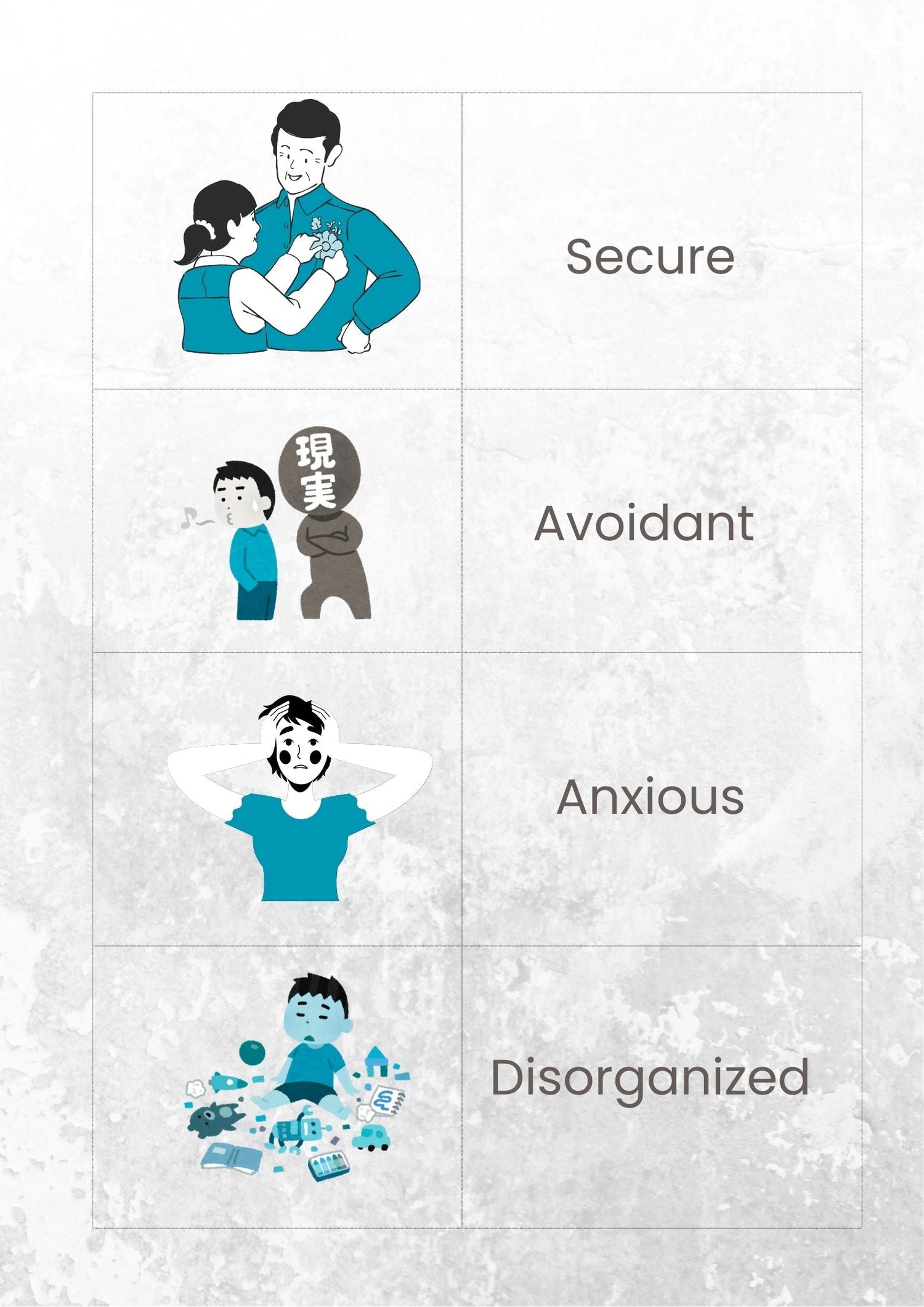Attachment Styles

How does each of the four attachment styles manifest in adults?
There are four primary attachment styles.
- Secure: Folks with this style form the most positive bonds when others. While they appreciate love and friendship, they recognize that everyone leads separate lives.
- Preoccupied: Those who fall into this category have an intense fear of abandonment. Because these folks will do anything to avoid rejection and loneliness, they often cling too tightly to those they love.
- Dismissive: Those who fall into this classification guard their alone-time and privacy.
- Disorganized: Those who fit this style suffered trauma in childhood or later in life. They want to have relationships, but they fear getting too close.
These four attachment styles manifest in adults:
1. Anxious / Preoccupied
For adults with an anxious attachment style, the partner is often the ‘better half.’
The thought of living without the partner (or being alone in general) causes high levels of anxiety. People with this type of attachment typically have a negative self-image, while having a positive view of others.
The anxious adult often seeks approval, support, and responsiveness from their partner.
People with this attachment style value their relationships highly but are often anxious and worried that their loved one is not as invested in the relationship as they are.
A strong fear of abandonment is present, and safety is a priority. The attention, care, and responsiveness of the partner appears to be the ‘remedy’ for anxiety.
On the other hand, the absence of support and intimacy can lead the anxious / preoccupied type to become more clinging and demanding, preoccupied with the relationship, and desperate for love.
2. Avoidant / Dismissive
The dismissing / avoidant type would often perceive themselves as ‘lone wolves’: strong, independent, and self-sufficient; not necessarily in terms of physical contact, but rather on an emotional level.
These people have high self-esteem and a positive view of themselves.
The dismissing / avoidant type tend to believe that they don’t have to be in a relationship to feel complete.
They do not want to depend on others, have others depend on them, or seek support and approval in social bonds.
Adults with this attachment style generally avoid emotional closeness. They also tend to hide or suppress their feelings when faced with a potentially emotion-dense situation.
3. Disorganized / Fearful-Avoidant
The disorganized type tends to show unstable and ambiguous behaviors in their social bonds.
For adults with this style of attachment, the partner and the relationship themselves are often the source of both desire and fear.
Fearful-avoidant people do want intimacy and closeness, but at the same time, experience troubles trusting and depending on others.
They do not regulate their emotions well and avoid strong emotional attachment, due to their fear of getting hurt.
4. Secure Attachment
The three attachment styles covered so far are insecure attachment styles. They are characterized by difficulties with cultivating and maintaining healthy relationships.
In contrast, the secure attachment style implies that a person is comfortable expressing emotions openly.
Adults with a secure attachment style can depend on their partners and in turn, let their partners rely on them.
Relationships are based on honesty, tolerance, and emotional closeness.
The secure attachment type thrives in their relationships but also don’t fear being on their own. They do not depend on the responsiveness or approval of their partners and tend to have a positive view of themselves and others.
Where do you stand?
Now that you are acquainted with the four adult attachment styles, you probably have an idea of which one you lean towards.
It is completely normal to recognize features of different styles in your history of intimate relationships. Attachment styles can change with major life events, or even with different partners.
When to worry?
Chances are that many of us don’t fully belong to the securely attached group.
Even if you think you have stable relationships, there might be patterns in your behavior that keep bothering you or keep making you stressed/unhappy. Unfortunately, some individuals will recognize themselves in one of the three insecure ‘profiles’ – the less healthy ones.
In that case, it is preferable and highly recommended that you address us your issue and get Dr. Myrna’s professional help.
Attachment Styles impacts
Here’s How Your Attachment Style impacts your mental and physical health
1. It Has Its Roots in your Core
Although you can alter your attachment style, the one you display today stems from incidents in childhood. You may have been so young that you don’t remember specific events that influenced you.
As such, you might assume it’s something you can’t change, and that false belief might drive you into depression. You might think, “I can never learn to trust again — what’s the point of relationships?” Start reaching out to the uplifting influencers in your life anyway.
2. It Affects your Closest Relationships
Your relationships with your spouse, kids and other close friends and family significantly influence your mental health. Numerous people seek therapy after a divorce, for example, but addressing your attachment style might prevent the split.
3. It Influences your Parenting Style
Psychologists recognize three basic parenting styles, and your attachment may influence your pattern:
- Permissive parents: spoiling the child and letting them do nearly anything they want. Those with a dismissive or disorganized attachment style might become this type of parent.
- Authoritative parents: These moms and dads run a tight ship and supervise nearly every aspect of their child’s lives. They may emphasize obedience over emotion, and those with either preoccupied or disorganized attachment styles may fit this profile.
- Authoritative parents: These people follow the ideal parenting pattern of blending caring with discipline. Those with secure attachment files often fit this profile.
4. It Strains your Cardiovascular Systems
Excess stress created by disorganized or preoccupied attachment styles doesn’t only spur habits like overeating or alcohol abuse. It can rewire the circuits in your brain to keep your blood pressure high, placing considerable strain on your heart.
5. It Influences your Weight
Dismissive, disorganized and preoccupied attachment styles can lead to family contact. Tension amps up your production of cortisol. While this stress hormone suppresses appetite in the short term, when the drama never relents, your body craves more food to prepare for ongoing battle. Worse, you tend to choose empty calories.
6. It Can Lead to Feelings of Loneliness
Any attachment style can fall prey to loneliness, but those who are disorganized may suffer most. People with this profile might desperately want to build a secure connection with others but lack social skills. Isolation can exacerbate multiple health problems, but therapy can help you learn ways to bond.
7. It May Worsen Chronic Pain
Your hormones signal your body to increase or decrease inflammation. For those with conditions like Crohn’s or rheumatoid arthritis, imbalances can lead to painful flares. Improving your emotional state by bettering your attachment style could lead to less frequent downtime.
8. It Can Exacerbate Anxiety and Depression
Finally, preoccupied, dismissive or disorganized attachment styles can directly or indirectly lead to anxiety and depression. For example, someone with a dismissive profile might lose their job for making too many mistakes and thinking, “no one cares anyway, so what’s the big deal.” When financial hardship occurs, they could sink into despair without a support system.
Someone with a preoccupied attachment style could fly into a panic if their kids aren’t home the second, they see streetlights glow. Over time, these ingrained overreactions can balloon into an anxiety disorder.
Those with disorganized patterns often have past trauma. When they can’t form positive relationships in the present, they lack the social support they need to process their emotions and move forward.





